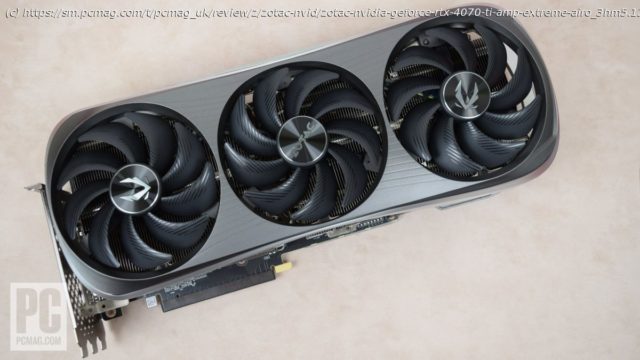A great graphics card—but only if it’s well priced
Nvidia’s newest graphics card, the Nvidia GeForce RTX 4070 Ti, does nothing to buck the recent trends of exponential performance gains paired with parallel rocketing prices. But, thanks to competition, this high-end card’s price isn’t quite as high as it was once slated to be. To evaluate the level of performance you should expect from the RTX 4070 Ti, we tested out Zotac’s Nvidia GeForce RTX 4070 Ti Amp Extreme Airo, which is one of the higher-end partner-made models of the RTX 4070 Ti. (There is no Founders Edition of the RTX 4070 Ti.) Now, there’s no question that the GeForce RTX 4070 Ti is a powerful piece of gaming hardware. However, it’s a card you’ll only want to buy if you see it at the right price. With Nvidia setting the base price for RTX 4070 Ti cards at $799.99, even the lowest expected price may be too high for most gamers.Design: I Was Once an RTX 4080
If you’ve been following along with Nvidia’s rollout of the RTX 40-series graphics cards so far, you’ll likely know that Nvidia initially announced two versions of the RTX 4080. These were the RTX 4080 16GB, and the RTX 4080 12GB. Ultimately Nvidia opted to change this arrangement, with the RTX 4080 16GB becoming the vanilla GeForce RTX 4080 that we reviewed in November. The RTX 4080 12GB, for its part, has been rebranded as the GeForce RTX 4070 Ti, which we are reviewing here.
Nvidia’s GeForce RTX 4070 Ti has a lot in common with the RTX 4080, just as you might expect from their original names. Both cards are built on the AD103 graphics chip that is based on the Ada Lovelace architecture and built using a customized 4nm TSMC manufacturing process. At first, this might give the impression that the two cards will perform similarly, but the AD103 chips used on RTX 4070 Ti graphics cards have been considerably cut down, leading to a noticeable performance rift.
Out of the 76 SMs available on an RTX 4080, the RTX 4070 Ti has access to only 60. This dramatically drops core counts from 9,728 CUDA cores, 304 TMUs, 112 ROPs, and 76 Ray Tracing (RT) cores on the RTX 4080 to just 7,680 CUDA cores, 240 TMUs, 80 ROPs, and 60 RT cores. Essentially a straight 26% drop in all hardware resources, which is matched by the change in VRAM capacity from 16GB of the RTX 4080 to just 12GB on the RTX 4070 Ti.
Nvidia increased the clock speed on the RTX 4070 Ti slightly to make up for its reduced resource count, but the 2,310MHz base clock and 2,610MHz boost clock on the reference RTX 4070 Ti do little to make up for the losses. This is especially true in the bandwidth department, as the RTX 4070 Ti also has just a 192-bit memory interface and slower VRAM, giving it only about 70% of the bandwidth that the RTX 4080 enjoys. This is notably less bandwidth than its direct predecessor, the Nvidia RTX 3070 Ti, had as well, as that card shipped with 608GBps of bandwidth.
Long story short, the changes made to the card lead to a significant drop in performance. Some of this was expected as it wouldn’t make sense for Nvidia to make two graphics cards that perform identically at very different prices, but we can’t help but feel Nvidia might have taken the cutbacks a bit too far with the RTX 4070 Ti.A Closer Look at the RTX 4070 Ti Amp Extreme Airo
Nvidia didn’t create Founders Edition models of the RTX 4070 Ti, so we tested a Zotac Nvidia GeForce RTX 4070 Ti Amp Extreme Airo card instead to gauge the performance of the RTX 4070 Ti family as a whole. This card is rather enormous and, though it gives the impression of being smaller than Nvidia’s RTX 40-series Founders Edition cards due to its rounded design, it’s actually considerably larger.
The downside to this is that the card isn’t going to fit well inside many cases, but it does have phenomenal cooling performance. That heatsink is simply huge, and the trio of fans installed over it resulted in far lower-than-expected operating temperatures during our thermal tests, which we will cover below. The card also has a decent factory overclock pushing the boost clock up to 2,700MHz.
Zotac opted to fit this card out with a new 12VHPWR power connector instead of old-fashioned PCI Express (PCIe) power connectors. This fits with Nvidia’s other RTX 40-series cards that have shipped so far, and the card includes an adapter for 12VHPWR to three eight-pin PCIe connectors for users that don’t yet have a power supply with 12VHPWR—which is almost everyone at the time of writing.






